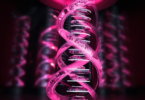Imagine fulfilling current global energy needs from humidity in the air.
Serbian inventor Nikola Tesla envisioned the concept of universal energy – power that would be drawn from the air itself and supplied to homes, machinery and vehicles, without wires or cables – as far back as 1899. While it may still sound like science fiction materials scientist Svitlana Lyubchyk and her twin son Andriy and Sergiy are out to prove it can be done. They are scheduled to demo technology which allows direct conversion of humidity in the air into electricity at PUZZLE X, a conference about future technologies taking place in Barcelona November 7-9.
The trio, who co-founded Lisbon-based CascataChuva, are not alone in their attempts to change atmospheric humidity into renewable energy but the company says it is poised to become the first to commercialize the technology. By the end of next year, the company hopes to begin producing a one-cubit meter sized device that can produce 10 kilowatts of electrical energy a day – enough to power the needs of one household up to 200 square meters – for 20 years or more. The devices will be designed to power individual apartments and places that can’t use solar energy. “We can directly install our system on the balconies or inside apartments and supply them with electric energy,” says Sergiy Lyubchyk. The company believes the electricity it generates can initially be sold for about 17 cents per kilowatt, far cheaper than the average price tag of 40 cents to 50 cents in France or Germany or the 24 cents charged in Portugal. Once manufacturing scales up CascataChuva believes that it will be able to match the 14 cent per kilowatt hour price tag of solar energy. The company is in talks with Swedish energy company Vattenfall about testing direct connections to the electrical grid when it begins piloting its technology at the end of 2024.
Creating energy from humidity in the air is attracting growing interest due to its potential to power a variety of applications, including Internet of Things objects such as wearable health devices, electronic skin sensors, and information storage devices. A team at the University of Massachusetts (UMass) Amherst, for example, published a paper declaring they had successfully generated a small but continuous electric current from humidity in the air – enough to light a single pixel on an LED screen. A team of researchers from the National University of Singapore’s (NUS) College of Design and Engineering (CDE) has developed a new moisture-driven electricity generation (MEG) device made of a thin layer of fabric – about 0.3 millimetres (mm) in thickness – made from sea salt, carbon ink, and a special water-absorbing gel – to generate electricity from the interaction with moisture in the air. Australian company Strategic Elements is working with the University of New South Wales and the The Commonwealth Scientific and Industrial Research Organization, (CSIRO) an Australian government agency responsible for scientific research to develop a flexible, self-charging battery technology that harvests electrical energy from moisture in the air to directly power devices. Meanwhile, Chinese scientists published a paper in Nature in June 2022 that explains how they were able to create sustainable power generation for at least one month from ambient humidity.
“What makes us all different is the materials we are using; there is no similarity in materials being used in all of these groups,” says Andriy Lyubchyk, CascataChuva’s CEO. Although the Portuguese startup is not ruling out Internet of Things applications it is first focusing on powering households . It is also targeting data centers and developing customized solutions for cooling systems such as refrigeration in tropical climates or as a source of power in areas of Africa or Asia where solar energy is not an option, such as jungles, says Svitlana Lyubchyk.
The company plans to generate revenue by selling humidity-to-electricity power systems to homeowners, commercial entities, independent power producers and resellers.
CascataChuva believes the technology could eventually generate as much as 500 X the global needs for electricity. “Our only limitation is geographies where there is a lack of humidity,” says Sergei Lyubchyk. For its technology to work humidity needs to be over 30%. “The higher the humidity, the better it is,” he says. Europe is an ideal environment, he says, as there is an average of 70% humidity.
A New Source Of Green, Renewable Energy
CascataChuva has a head start on other researchers.
When Svitlana Lyubchyk, a materials scientist, moved from Ukraine to Portugal about 20 years ago, she was hired as the coordinator of a European project to develop materials that will help kill airborne microorganisms. While she was doing these experiments her twin sons, who were students at the time, noticed that humidity was generating output signals from the samples they were investigating.“We immediately understood that this is a new source of energy,” she says.
The company has been working on the technology since 2015 and initially was ridiculed. “We were considered freaks,” says Andriy Lyubchyk.
Over time the Lyubchyks refined their approach by engineering a nanomaterial that captures airborne water molecules and directs their movement through nanoscale channels, yielding an electric charge. The challenge was to create a device that allow continuous operation under ambient conditions. This nanoscience breakthrough has helped the company achieve what the company calls “remarkable efficiency” in generating electricity.
The team built a 4 cm-diameter version of the device, which it patented in 2018, which can power a light bulb or a cell phone charger. It will demo this at PUZZLE X. The washing machine-sized device for powering homes it plans to produce in 2024 will be made up of about 20,000 of these devices stacked into a single cube. A converter, like those used with solar panels, will be needed to convert the energy into AC electricity.
The company has received € 5.5 million in non-equity grants from the European Innovation Council (EIC) as part of its CATCHER program.
The company’s work has not been published in scientific journals because of EU patent rules but it is being continuously peer-reviewed by independent top research/business experts that evaluate it for the EIC, says Svitlana Lyubchyk, who like her sons, has both Portuguese and Ukrainian citizenship.
CascataChuva is currently raising funding to ramp up manufacturing of the larger devices, using existing industrial machines.
“Our goal was to try and make the creation of energy using this process very efficient,” says Andriy Lyubchyk. “Now we have good results and are confident that we will be able to create a new renewable energy source to benefit humanity.”
This article is content that would normally only be available to subscribers. Sign up for a four-week free trial to see what you have been missing.
To read more of The Innovator’s FutureScope articles click here.
FutureScope is a series of articles created by The Innovator in partnership with PuzzleX, a conference about future technologies. The articles give insights to both The Innovator’s subscribers and PUZZLE X‘s attendees on topics that will be tackled at the November conference in Barcelona.



